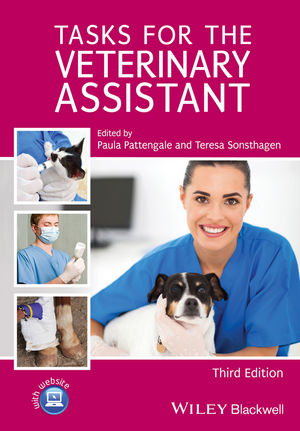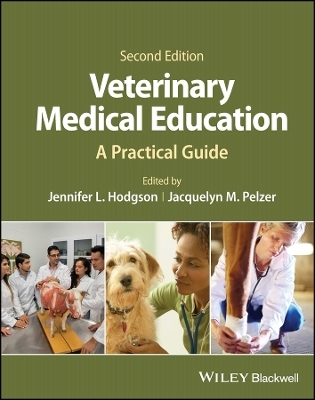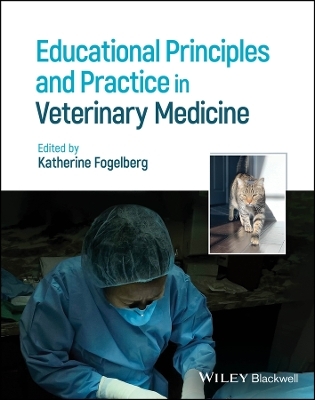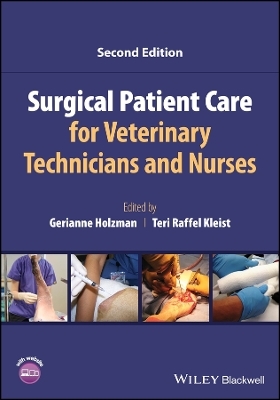
Tasks for the Veterinary Assistant
John Wiley & Sons Australia Ltd (Verlag)
978-1-118-44078-0 (ISBN)
- Titel erscheint in neuer Auflage
- Artikel merken
Tasks for the Veterinary Assistant, Third Edition
provides practical, step-by-step instructions for preparing and
performing a wide range of veterinary assisting tasks. With
expanded coverage of large animal and exotic restraint, anatomy and
physiology, nutrition and feeding, digital radiography, and
electronic medical records and client communication, this revised
edition now includes why and when to perform each task with the
preparation and procedure information. The book includes
everything from appearance and professional language to equipment
maintenance and dental and surgical assisting, making it equally
useful for learning new techniques or as a memory refresher.
Offering a detailed, comprehensive guide to all aspects of
veterinary assisting, the book is written using an accessible,
user-friendly style. A companion website offers figures from
the book, downloadable flash cards, lesson plans, exams, a
competency checklist, and concept maps. Tasks for the
Veterinary Assistant is equally useful for acquiring new skills
and gaining confidence in the veterinary practice, making it
invaluable for veterinary assistant students and veterinary
assistants of all experience levels.
Editors Paula Pattengale, DVM, MA, developed the Veterinary Assistant program at North County Regional Occupational Program in San Jose, California and Mission Valley Regional Occupational Program in Fremont, California, USA. She is now retired from teaching. Teresa Sonsthagen BS, LVT, is a Co-director and Senior Lecturer in the Veterinary Technology Program at North Dakota State University in Fargo, North Dakota, USA. She is an author of other veterinary technology textbooks and has been educating veterinary technologists for over 30 years.
Contributors xvii
Preface xix
Acknowledgments xxi
About the companion website xxiii
Chapter 1 Foundation Skills 3
Tregel Cockburn
Task 1.1 Self-Assessment and Understanding of Foundation Skills 5
Task 1.2 Analysis of Veterinary Medical Terminology 6
Task 1.3 Review of Basic Math Skills 9
Task 1.4 Solving Common Veterinary Medical Math Problems 10
Task 1.5 Computers and Information Literacy 15
Task 1.6 Developing Technocompetency 17
Chapter 2 Professional Conduct 21
Oreta M. Samples
Task 2.1 Meeting Employer Expectations 23
Task 2.2 Using Common Courtesies 24
Task 2.3 Uses and Misuses of Social Media 26
Task 2.4 Applying the Human–Animal Bond 27
Task 2.5 Professional Appearance 29
Task 2.6 Using Appropriate Language 31
Task 2.7 The Role of the Veterinary Assistant 33
Task 2.8 Anticipating Work Flow 36
Task 2.9 Applying Veterinary Ethics 37
Chapter 3 Laws Affecting Veterinary Practice 41
Barb Burri
Task 3.1 Common Law 43
Task 3.2 Statutory Laws 44
Task 3.3 Substantive Law 44
Task 3.4 Federal Laws 46
Task 3.4.1 Occupational Safety and Health 48
Task 3.4.2 Product Safety Labels 49
Task 3.4.3 Personal Protective Equipment 51
Task 3.4.4 Universal Precautions 52
Task 3.4.5 Gloving and Ungloving 53
Task 3.5 State Laws 56
Task 3.5.1 Veterinary Practice Acts 56
Task 3.5.2 Public Health and Vaccination Laws 59
Task 3.5.3 State Animal Laws 60
Task 3.6 Local Ordinances 61
Chapter 4 Front Office Procedures 65
Paula Pattengale
Task 4.1 Medical Record Assembly 68
Task 4.2 Color Coding Medical Records 70
Task 4.3 Filing 72
Task 4.4 Appointment Scheduling 74
Task 4.5 Updating Client Information 77
Task 4.6 Intake Procedures 78
Task 4.7 The Signalment 80
Task 4.8 Release of Patient Information 82
Task 4.9 Rabies Certificates 84
Task 4.10 Health Certificates and Interstate Shipment of Animals 86
Task 4.11 Consent Forms 88
Task 4.12 Client Communications 90
Task 4.13 Patient Discharge 92
Task 4.14 Telephone Techniques 94
Task 4.15 Handling Difficult Clients 97
Task 4.16 Hospital Closing Procedures 99
Chapter 5 Disease Transmission, Control, and Prevention 103
Jennifer Serling
Task 5.1 Disease Transmission 105
Task 5.2 Levels of Sanitation and Sanitation Agents 108
Task 5.3 Cage and Kennel Cleaning 112
Task 5.4 Isolation Ward Rules and Sanitation 116
Task 5.5 Cleaning the Other Areas in the Veterinary Clinic 118
Task 5.6 Handling Hospital Laundry 121
Task 5.7 Hospital Waste: Hazardous and Nonhazardous 123
Chapter 6 Introduction to Animals 127
Tammie Pearce
Task 6.1 Scientific Classification 129
Chapter 7 Anatomy and Physiology 137
Barb Burri
Task 7.1 External Landmarks 139
Task 7.2 Directional Terms 141
Task 7.3 Cells and Tissues 142
Task 7.4 Skeletal System 143
Task 7.5 Muscular System 144
Task 7.6 Cardiovascular System 146
Task 7.7 Immune System 147
Task 7.8 Respiratory System 149
Task 7.9 Digestive System 150
Task 7.10 Urinary System 152
Task 7.11 Reproductive System 153
Task 7.12 Nervous System 154
Task 7.13 Endocrine System 155
Task 7.14 Integumentary System 156
Chapter 8 Nutrition 159
Paula Pattengale
Task 8.1 The Basics: Essential Nutrients 161
Task 8.2 How Much to Feed 163
Task 8.3 Determination of Basic Energy Requirements (BER) 164
Task 8.4 Determination of the Maintenance Energy Requirement (MER) or Caloric Needs of a Patient 165
Task 8.5 Feeding the Anorexic Patient 166
Task 8.6 Feeding Prescription Diets 167
Task 8.7 Reading a Pet Food Label 167
Task 8.8 Calculating the True Cost of Feeding a Pet 168
Task 8.9 Feeding Livestock and Poultry 169
Task 8.10 Examination of Forages for Quality 170
Task 8.11 Feeding of Other Species 171
Chapter 9 Ropes and Knots 173
Teresa Sonsthagen
Task 9.1 Knot Tying Terminology 175
Task 9.2 Types of Ropes 176
Task 9.3 Whipping 176
Task 9.4 Hanking a Rope 179
Task 9.5 Types of Knots and Hitches 180
Task 9.5.1 Halter Tie 180
Task 9.5.2 Square Knot 181
Task 9.5.3 Reefer’s Knot 183
Task 9.5.4 Sheet Bend Knot 185
Task 9.5.5 Bowline 187
Task 9.5.6 Bowline on a Bight 189
Task 9.5.7 Hitches 190
Task 9.5.8 Clove Hitch 192
Chapter 10 Animal Restraint 195
Teresa Sonsthagen
Task 10.1 Species Differences and Safety 197
Task 10.2 Deciding on a Restraint Technique 200
Task 10.3 Psychological Restraint 202
Task 10.4 Physical Restraint 203
Task 10.4.1 Patient Identification Procedure 204
Task 10.5 Patient Kenneling Techniques 205
Task 10.5.1 Placing a Dog or Cat into a Kennel 205
Task 10.5.2 Remove a Dog or Cat from a Kennel 206
Task 10.5.3 Placing a Larger Dog into a Run 207
Task 10.5.4 Removing a Large Dog from a Kennel 208
Task 10.6 Lifting Animals 209
Task 10.7 Restraint Procedures for Dogs and Cats 210
Task 10.7.1 General Restraint 211
Task 10.7.2 Head Restraint for Examination or Medications 213
Task 10.7.3 Recumbency Restraint 215
Task 10.7.4 Restraint for Injections 217
Task 10.7.5 Restraint for IV Injections, Venipuncture, and Catheterization 218
Task 10.8 Handling Fractious Patients 225
Task 10.8.1 Fractious Cats 225
Task 10.8.2 Fractious Dogs 227
Task 10.9 Elizabethan Collar, Neck Brace, and Hobbles 230
Task 10.10 Restraint Procedures for Other Species 232
Task 10.10.1 Haltering and Leading a Horse 232
Task 10.10.2 Rabbits 234
Task 10.10.3 Avian Restraint 236
Chapter 11 Patient Care I 241
Oreta M. Samples
Task 11.1 Medical Records 244
Task 11.1.1 Treatment Plan 245
Task 11.2 Working in the Treatment Room 248
Task 11.3 Examination Room Preparation 249
Task 11.4 Patient Discharge or Hospitalization 253
Task 11.5 Meeting a Patient’s Basic Needs 255
Task 11.5.1 Environmental Considerations 257
Task 11.5.2 Feeding the Hospitalized Patient 259
Task 11.5.3 Water Availability and Consumption 262
Task 11.5.4 Socialization and Exercise 264
Task 11.5.5 In-Hospital Grooming 267
Task 11.6 Caring for the Feral or Quarantined Animal 268
Chapter 12 Patient Care II 271
Paula Pattengale
Task 12.1 Grooming of Outpatients 273
Task 12.2 Coat Grooming Tools 273
Task 12.3 Ear Cleaning 276
Task 12.4 Nail Trimming 278
Task 12.5 Expressing Anal Sacs 281
Task 12.6 Bathing and Dipping 284
Task 12.7 Clipper Maintenance 287
Task 12.8 Clipping a Bird’s Flight Feathers 290
Task 12.9 Administration of Medication 291
Task 12.9.1 Administration of Medication: Oral 291
Task 12.9.2 Administering Medication: Aural 295
Task 12.9.3 Administering Medication: Topical Medications 297
Task 12.9.4 Administering Medication: Ophthalmic 299
Task 12.9.5 Administration of Medications: Parenteral 300
Task 12.9.6 Filling Syringes 302
Task 12.10 Mixing Vaccines 305
Task 12.11 Daily Dental Care 306
Chapter 13 Patient Care III 309
Natalie Clawsen
Task 13.1 Vital Signs 311
Task 13.1.1 Determining the Body Weight and the Body Condition Score 311
Task 13.1.2 Determining the Respiratory Rate 313
Task 13.1.3 Determining the Pulse and the Heart Rate 313
Task 13.1.4 Determining the Core Body Temperature 315
Task 13.2 Pain Evaluation and Monitoring 317
Task 13.3 Sexing Animals 320
Task 13.3.1 Sexing a Cat 320
Task 13.3.2 Sexing a Rabbit 321
Task 13.3.3 Sexing Rats, Mice, Hamsters, and Gerbils 322
Task 13.3.4 Sexing a Guinea Pig 324
Task 13.4 Monitoring IV Fluid Administration and IV Catheter Maintenance 326
Task 13.4.1 Preparation of a Patient for IV Catheterization 327
Task 13.4.2 Maintain Catheter Patency, Site, and Bandage 328
Task 13.5 Wound Care and Bandaging 330
Task 13.5.1 Cleaning a Wound 331
Task 13.5.2 Applying a Simple Bandage 332
Task 13.5.3 Removing a Simple Bandage 337
Task 13.6 Emergency Support 338
Task 13.6.1 Maintenance of a Crash Cart and Emergency Station 339
Task 13.6.2 Assisting Effectively during a Patient Emergency 340
Task 13.7 Veterinary Hospice Care 342
Task 13.7.1 Support of a Patient’s Emotional Well-Being 343
Task 13.7.2 Bedding and Recumbency Changes 344
Task 13.8 Euthanasia 346
Task 13.8.1 Preparation for Euthanasia 346
Task 13.8.2 Role during the Process of Euthanasia 348
Task 13.8.3 Follow-Up after Euthanasia 350
Chapter 14 Laboratory Skills 353
Eloyes Hill and Teresa Sonsthagen
Task 14.1 Maintenance of the Binocular Microscope 357
Task 14.2 Using the Centrifuge 358
Task 14.3 Calibrating the Refractometer 359
Task 14.4 Identification and Sampling for Ectoparasites 360
Task 14.4.1 Preparation of an Ectoparasite Sample Collection Tray 362
Task 14.5 Identification and Sampling for Endoparasites 363
Task 14.6 Collection of Feces 364
Task 14.7 Examination of Feces 365
Task 14.7.1 Preparation of the Fecal Smear 366
Task 14.7.2 Standard Fecal Flotation 367
Task 14.8 Blood Collection and Handling 369
Task 14.8.1 Components of a Blood Sample 369
Task 14.8.2 Complete Blood Count 372
Task 14.8.3 Preparing the Blood Smear 373
Task 14.8.4 Staining the Blood Smear 375
Task 14.8.5 Packed Cell Volume 377
Task 14.8.6 Plasma Protein Determination 378
Task 14.9 Blood Chemistry and Electrolyte Determinations 380
Task 14.10 Using Serological Test Kits 382
Task 14.11 Urine Collection 384
Task 14.12 Urinalysis 387
Task 14.13 Microbiology: Sample Collection 390
Task 14.13.1 The Gram Stain 392
Task 14.13.2 Inoculation of Media 394
Task 14.13.3 Antibiotic Sensitivity Testing 397
Task 14.14 Necropsy: Preparation and Follow-Up 399
Task 14.14.1 Preparing Samples for Shipment to the Reference Laboratory 402
Chapter 15 Diagnostic Imaging 405
Teresa Sonsthagen
Task 15.1 Introduction to Diagnostic Imaging 407
Task 15.2 Radiation Safety 409
Task 15.3 Preparation for Radiographic Procedure 412
Task 15.3.1 Preparation: Radiography Log 413
Task 15.3.2 Preparation: Personal Protective Equipment (PPE) 415
Task 15.3.3 Preparation: Using the Calipers 416
Task 15.3.4 Preparation: Setting Exposure Factors Using Technique Charts 417
Task 15.3.5 Preparation: Cassette Selection and Film Identification 419
Task 15.3.6 Procedure: Taking a Radiograph—Patient Positioning 421
Task 15.4 Developing Radiographic Film 423
Task 15.4.1 Film Handling 424
Task 15.4.2 Developing Film 426
Task 15.5 Film Filing 427
Task 15.6 Darkroom Maintenance 428
Task 15.7 Diagnostic Ultrasonography 430
Chapter 16 Endoscopy 433
Oreta M. Samples
Task 16.1 Endoscope Instrument 435
Task 16.2 Endoscopy Preparation 438
Task 16.3 Endoscopy: Postprocedure 442
Chapter 17 Dental Skills for the Veterinary Assistant 447
Mary l. Berg
Task 17.1 The Assistant’s Role in Veterinary Dentistry 449
Task 17.2 Dental Instruments, Equipment, and Maintenance 449
Task 17.3 Daily Dental Care 455
Task 17.4 Charting the Oral Examination 455
Task 17.5 Dental Anatomy 460
Task 17.6 Estimation of Age Based on Tooth Eruption 461
Task 17.7 A Dental Prophylaxis Can Be Hazardous to Your Health! 462
Task 17.8 How to Clean Teeth 462
Task 17.9 Basics of Pocket Pet Dentistry 463
Task 17.10 Intraoral Radiography 464
Task 17.10.1 Patient Positioning during Dental Radiography 465
Task 17.11 Dental Patient Discharge Instructions 466
Chapter 18 Pre- and Perisurgical Skills 469
Elizabeth Brotherton, Paula Pattengale, and Teresa Sonsthagen
Task 18.1 Aseptic Technique 471
Task 18.2 Surgical Suite Maintenance 472
Task 18.3 Communication with Health-Care Team Members 475
Task 18.3.1 Medical Records 476
Task 18.3.2 Patient Anesthetic Record 476
Task 18.3.3 Surgery Logbook 479
Task 18.3.4 Controlled Substance Log 480
Task 18.4 Preanesthetic Patient Identification and Preparation 483
Task 18.5 Induction of Anesthesia 486
Task 18.6 Anesthetic Equipment and Anesthetic Machine Setup 494
Task 18.7 Surgical Site Preparation 498
Task 18.8 Surgical Packs in Presurgical Period 503
Task 18.8.1 Suture Materials, Needles, and Scalpels 506
Task 18.9 Gloving and Glove Packs 507
Task 18.10 Frequently Performed Surgical Procedures 509
Chapter 19 Postoperative Techniques 513
Teresa Sonsthagen and Elizabeth Warren
Task 19.1 Postanesthetic Patient Care 515
Task 19.1.1 Extubation 517
Task 19.1.2 Emergencies in the Postanesthetic Period 519
Task 19.2 Postoperative Patient Care 520
Task 19.2.1 Client Communication 523
Task 19.2.2 Suture and Staple Removal 524
Task 19.3 Sterilization and Sterilizers 526
Task 19.4 Cleaning and Preparing Instruments and Supplies 529
Task 19.5 Identifying Surgical Instruments 530
Task 19.6 Surgical Pack Assembly 533
Task 19.7 Postoperative Surgery Room Cleaning 540
Chapter 20 Pharmacy Skills 543
Jennifer Serling
Task 20.1 “Five Patient Rights” 545
Task 20.2 Reading a Prescription and Determining How Much to Dispense 546
Task 20.3 Information Contained on the Primary Container or Packing 547
Task 20.4 Prescription Labeling 549
Task 20.5 Prescription Packaging 551
Task 20.6 How to Use a Pill Counting Tray 552
Task 20.7 Handling Medications and Controlled Substances 554
Task 20.8 Explaining Prescriptions to the Owner 556
Chapter 21 Veterinary Practice Routines 559
Paula Pattengale
Task 21.1 Wellness Programs 561
Task 21.2 Using Practice Protocols 564
Task 21.3 Inventory Control 565
Task 21.4 In-House Communications 568
Task 21.5 Client Communication 570
Task 21.6 Letter Writing 571
Appendices 575
Appendix A: SCANS Competencies and Foundation Skills 575
Appendix B: Suffixes, Prefixes, and Anatomical Terms (Roots) 577
Appendix C: Directional Terms 587
Appendix D: Metric System and Table of Equivalents 589
Appendix E: Common Name, Genus Name, Scientific Name, and Gender Term for Common Species 591
Appendix F: Abbreviations Used in Veterinary Practice 593
Appendix G: Normal Vital Signs 595
Appendix H: Body Condition Score 597
Appendix I: Blood Collection Tube Types 599
Appendix J: Blood Collection Protocol 601
Appendix K: Pain Scale for Cats 603
Glossary 607
Index 617
| Verlagsort | Milton, QLD |
|---|---|
| Sprache | englisch |
| Maße | 195 x 233 mm |
| Gewicht | 1154 g |
| Themenwelt | Veterinärmedizin |
| ISBN-10 | 1-118-44078-1 / 1118440781 |
| ISBN-13 | 978-1-118-44078-0 / 9781118440780 |
| Zustand | Neuware |
| Informationen gemäß Produktsicherheitsverordnung (GPSR) | |
| Haben Sie eine Frage zum Produkt? |
aus dem Bereich



